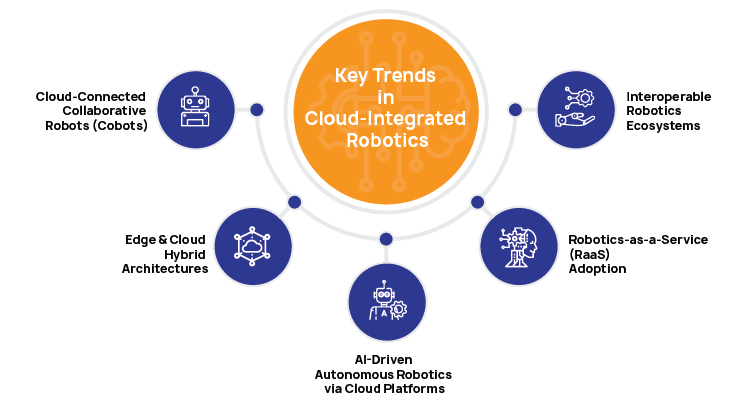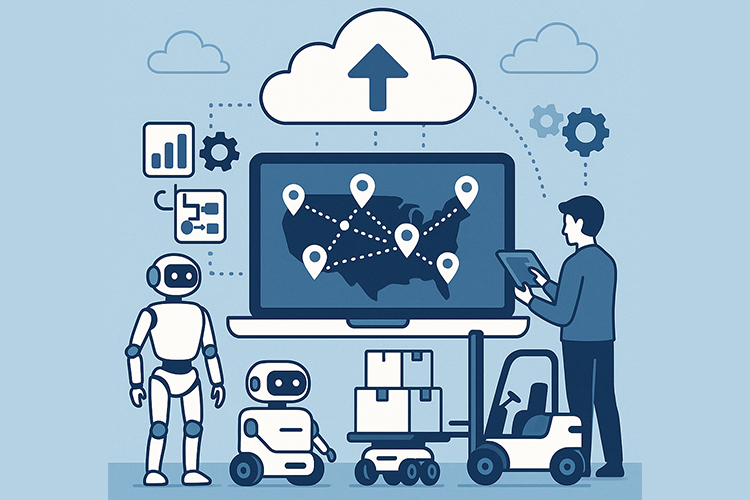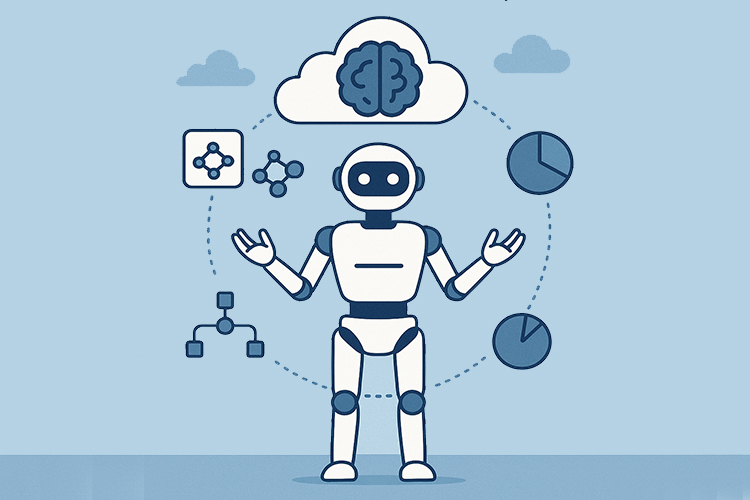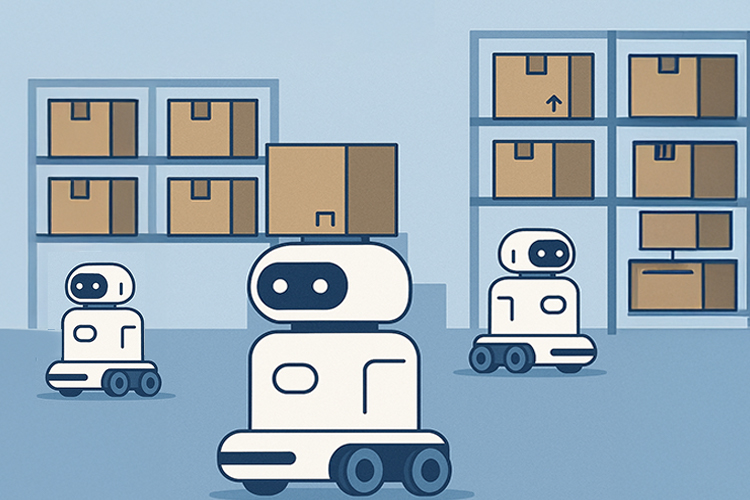


Srikanth Sharma
5 Minutes read
Cloud-Integrated Robotics: Advancing Automation in Manufacturing
As industries continue to embrace automation, cloud-integrated robotics is emerging as a game-changer in the manufacturing sector. Traditionally, robots in factories operated independently or within isolated systems with limited connectivity. However, with the rise of cloud technology, manufacturers can now integrate robotic systems into centralized, flexible platforms that offer significant advantages in scalability, data analytics, and real-time collaboration.
Why Cloud-Integrated Robotics?
By leveraging cloud infrastructure, manufacturers can remotely manage, monitor, and optimize their robotic systems. This integration not only enhances operational efficiency but also fosters continuous innovation. With cloud computing, manufacturers gain access to vast computational power, real-time data analytics, and machine learning capabilities to streamline automation workflows and predict maintenance requirements. Moreover, cloud-connected robots can communicate seamlessly with other machines, employees, and even suppliers, creating a truly intelligent factory ecosystem.
In this blog, we’ll explore how cloud technology is revolutionizing robotics in manufacturing. From enhanced flexibility and cost savings to real-time decision-making, cloud-integrated robotics is paving the way for a new era of smart manufacturing. Join us as we delve into the key trends, challenges, and future opportunities in this exciting field.
Market Insights: Growing Adoption and Key Drivers
Cloud-integrated robotics in the manufacturing sector is experiencing significant growth, driven by advancements in cloud computing, AI, and IoT. However, several key drivers and challenges are shaping its adoption and implementation.
- Increased Demand for Flexible Automation: Manufacturers increasingly seek automation solutions that can adapt to evolving production requirements. Cloud-connected robots offer the flexibility to be reprogrammed and updated remotely, enabling rapid adjustments without extensive reconfiguration.
- Emergence of Robotics-as-a-Service (RaaS): The RaaS model is gaining popularity, allowing companies to access robotic capabilities without significant upfront investments. This approach lowers barriers to entry and accelerates the adoption of robotics in manufacturing environments.
- Advancements in AI and Machine Learning: Integration of AI and machine learning with cloud robotics enhances decision-making processes, enabling robots to perform complex tasks and adapt to dynamic manufacturing environments.
Key Trends in Cloud-Integrated Robotics
Cloud-integrated robotics is transforming the manufacturing landscape with several emerging trends that are accelerating adoption and innovation:

Cloud-Connected Collaborative Robots (Cobots)
- Cobots are increasingly connected to cloud platforms for centralized data analysis, remote updates, and behavior optimization.
- Use cases: Real-time production line adjustments, dynamic safety reconfigurations, and cloud-based task scheduling.
Edge & Cloud Hybrid Architectures
- Manufacturers are deploying hybrid systems where real-time decision-making occurs at the edge, while the cloud handles long-term data analytics, machine learning model training, and fleet management.
- Enables low-latency operation with scalable analytics and remote orchestration.
AI-Driven Autonomous Robotics via Cloud Platforms
- Cloud-hosted AI models (e.g., in AWS, Azure, GCP) allow robots to continuously learn and update from aggregated factory data like object recognition, route optimization, and anomaly detection in quality control.
Robotics-as-a-Service (RaaS) Adoption
- Subscription-based, cloud-controlled robots reduce CapEx and allow on-demand deployment and scaling of robotic systems. Especially valuable for small and mid-sized manufacturers.
Interoperable Robotics Ecosystems
- Standardized cloud APIs and digital twin integration (e.g., Siemens, PTC, Azure Digital Twins) enable manufacturers to simulate, integrate, and coordinate mixed-robot fleets from different vendors.
Key Challenges in Implementation
In the contemporary industrial landscape, the increasing integration of robotic systems to optimize operational efficiency necessitates sophisticated strategies for robotic fleet management and coordination. The deployment of substantial robotic fleets in environments such as warehouses, manufacturing facilities, and logistics hubs underscores the critical need for uninterrupted and cohesive operation.
Cloud-integrated robotics offers a robust and scalable solution for addressing these complex management challenges. Cloud platforms enable real-time monitoring, comprehensive data acquisition, and centralized fleet coordination, surpassing the capabilities of conventional on-premise solutions. By leveraging cloud infrastructure, robotic units can establish seamless communication with each other and a central management system, thereby enabling the exchange of essential data.
This connectivity supports dynamic routing protocols, efficient task allocation, and optimized resource utilization. Such coordination not only enhances the performance metrics of individual robots but also significantly improves overall fleet efficiency, leading to reduced operational costs and minimal downtime. Furthermore, cloud platforms provide the flexibility to modulate the scale of robotic deployments in response to fluctuating demand patterns. The integration of advanced data analytics and machine learning techniques further enhances the capacity for intelligent fleet management.
Let’s dive deeper into a few key use cases and explore how cloud integration can effectively address them:
Use Case 1: Robotic Fleet Management and Coordination in Cloud-Integrated Robotics
As industries increasingly adopt robotic systems to enhance operational efficiency, the need for effective robotic fleet management and coordination becomes more critical. When a large number of robots are deployed in environments like warehouses, factories, or logistics centers, ensuring their seamless operation is essential. Cloud-integrated robotics offers a powerful solution for managing these fleets. The cloud enables real-time monitoring, data collection, and fleet coordination at a scale that traditional on-premises solutions cannot support. By leveraging cloud infrastructure, robots can communicate with each other and a central management system to share critical data, enabling dynamic routing, task allocation, and resource optimization. This coordination not only improves the efficiency of individual robots but also enhances overall fleet performance, reducing operational costs and downtime.

Cloud platforms also provide the flexibility to scale robotic systems up or down based on demand. With advanced data analytics and machine learning algorithms running in the cloud-based infrastructure, these systems can predict maintenance needs, automate troubleshooting, and optimize operations. Additionally, cloud-based platforms allow for seamless updates and integration of new robotic models, ensuring that companies can rapidly adopt innovations without significant system overhauls. Ultimately, cloud-integrated robotic fleet management enables industries to deploy, manage, and evolve their robotic systems more effectively, paving the way for smarter, more resilient operations in various sectors such as manufacturing, healthcare, logistics, and agriculture.
The Challenges
- Optimizing resource allocation and productivity
- Improving maintenance and minimizing downtime
- Enhancing collaboration between robots and humans
The Solution
- Cloud-based centralized coordination systems
- Dynamic scheduling & task allocation based on robot availability
- Predictive maintenance, health, and energy management
- Scalability & flexibility fleet management
Benefits
- Increased operational efficiency
- Improved collaboration between robots
- Enhanced scalability
- Real-time monitoring and decision-making
Use Case 2: Enhancing Robotic Decision-making and Autonomy through Cloud-based AI/ML
Using cloud-based data lakes and model training environments, robots can continually improve their decision-making capabilities and adapt to new environments or tasks. Cloud computing enables the use of large datasets to train machine learning models, resulting in more intelligent robots capable of complex tasks such as path planning, object recognition, or human-robot interaction.

The Challenges
- Ensuring high-quality, clean, and consistent data for effective training and decision-making.
- Overcoming latency issues in decision-making processes.
- Developing scalable, adaptable, and effective AI/ML models to handle diverse scenarios and environments.
The Solution
- Data Preprocessing: Implement robust data cleaning, preprocessing, and normalization pipelines to ensure data quality before feeding it into AI/ML models.
- Edge Computing: Deploying edge devices to perform initial AI/ML processing on-site can reduce latency by processing critical data locally before sending it to the cloud. This ensures quicker decisions and actions.
- AutoML: Leverage AutoML platforms to automate the process of training, optimizing, and deploying machine learning models, allowing manufacturers to scale AI-driven decision-making without requiring deep ML expertise.
Benefits
- Increased automation leads to streamlined workflows, reduced downtime, and higher throughput.
- The ability to quickly scale robotic operations and adapt to changes in manufacturing needs
- Access to real-time data analytics and feedback for ongoing optimization and process improvement.
Use Case 3: Autonomous Mobile Robots (AMRs) for Logistics and Warehousing
Autonomous Mobile Robots (AMRs), equipped with advanced navigation sensors and AI software, can move independently within dynamic environments. Real-time data from AMRs is sent to the cloud, allowing warehouse managers to track inventory, optimize robot routes, and ensure that all assets are in the right location at the right time.

The Challenges
- Navigation and Obstacle Avoidance in Dynamic Environments: Ensuring precise navigation and reliable obstacle detection in constantly changing warehouse environments.
- Integration with Legacy Systems and Existing Infrastructure: Seamless integration with existing warehouse management systems (WMS) and automation infrastructure.
- Safety and Human-Robot Interaction (HRI): Ensuring safe interaction between AMRs and human workers in dynamic environments.
The Solution
- Advanced Mapping and SLAM: Leveraging Simultaneous Localization and Mapping (SLAM) algorithms to help AMRs continuously map their environment and adjust their navigation paths in real-time to account for changes in the warehouse.
- API-Driven Integration: Implementing API-based integrations to enable seamless communication between AMRs and legacy systems, ensuring smooth data exchange and coordination between robots and existing warehouse technologies.
- Advanced Safety Sensors and AI: Equipping AMRs with AI-powered vision systems, LiDAR, and radar sensors to enhance their ability to detect and avoid humans, moving obstacles, and sudden changes in the environment. This allows AMRs to slow down or change their path when approaching humans.
Benefits
- Increased Operational Efficiency and Throughput: Faster and more efficient material handling and transportation within the warehouse.
- Enhanced Safety and Reduced Risk of Injury: Safer working conditions for human employees by reducing human error and accidents.
- Cost Reduction and Improved ROI: Significant cost savings over time through automation and reduced labor costs.
Conclusion
Cloud-integrated robotics is poised to redefine the future of manufacturing by enabling smarter, more agile, and scalable automation. By leveraging the power of cloud platforms, manufacturers can unlock real-time data analytics, centralized control, remote monitoring, and AI-driven insights across their robotic operations. While challenges such as data privacy, latency, and integration with legacy systems persist, advancements in hybrid cloud-edge architectures, Robotics-as-a-Service (RaaS), and interoperable platforms are steadily addressing these barriers. As manufacturers continue to embrace Industry 4.0 and move toward highly responsive, digitally connected production environments, cloud-integrated robotics will play a pivotal role in enhancing operational efficiency, reducing downtime, and driving innovation at scale.
ACL Digital brings deep expertise in cloud technologies, AI/ML, robotics, and industrial automation, giving manufacturers and enterprises a competitive edge in deploying next-generation robotic solutions. With a proven track record in delivering scalable, cloud-integrated architectures and intelligent automation frameworks, ACL Digital empowers businesses to transform operations, optimize robotic fleet management, and accelerate digital transformation. Our end-to-end capabilities, ranging from IoT platform development and edge computing integration to real-time data analytics and AI-driven decision-making, enable clients to unlock the full potential of cloud-integrated robotics and thrive in the era of Industry 4.0.
Connect with our experts to learn more in detail.
Related Insights


The Architecture of Agentic RAG: Reasoning-Driven AI Systems Explained


The AI Developer’s Guide to Data Formats: TOON vs. JSON and Beyond


